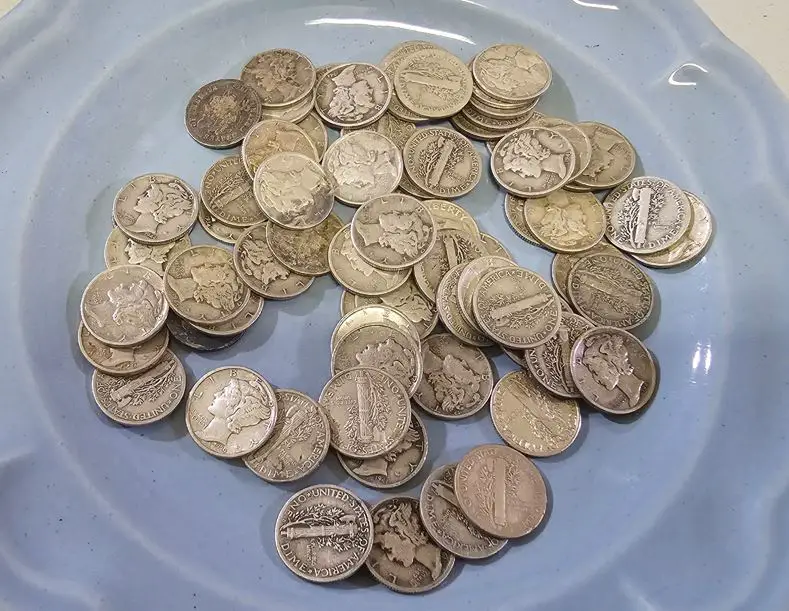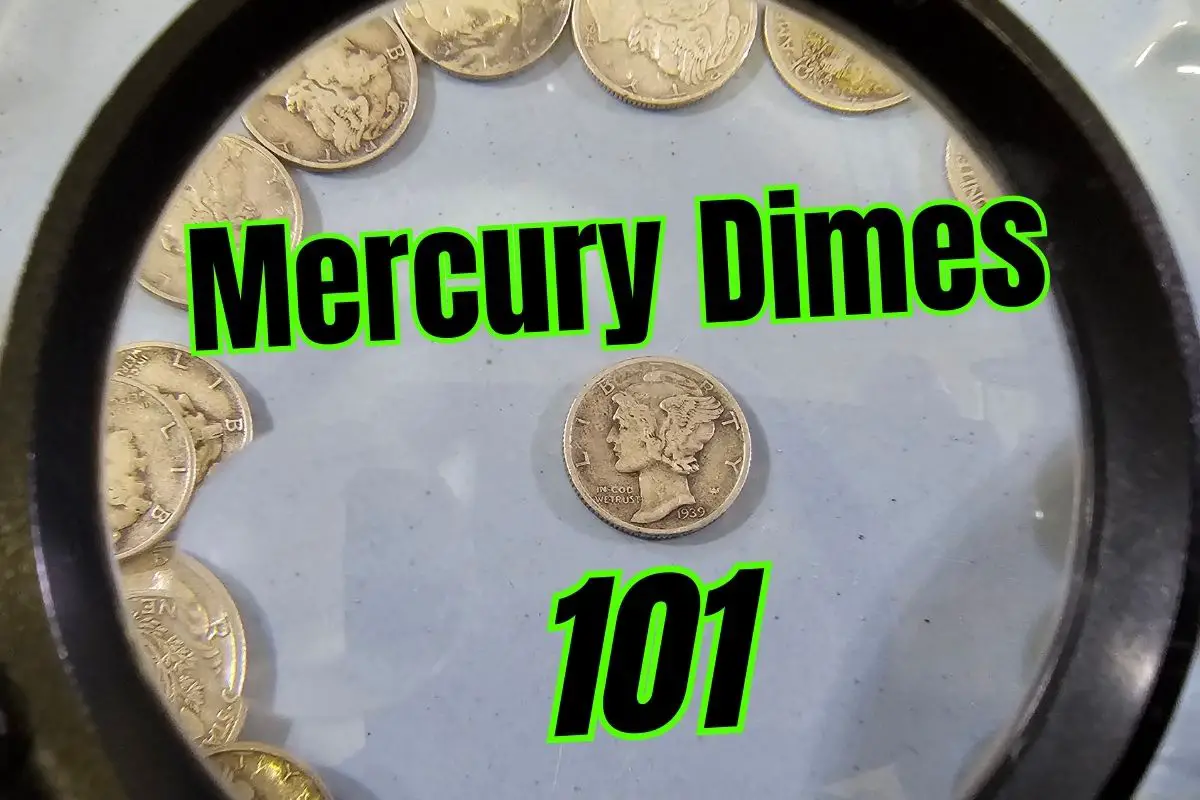If you metal detect, you already know the rush of seeing a silver rim peeking out of the plug—but don’t toss that “common” dime into the junk pouch just yet. Pre-1965 U.S. dimes are 90% silver, and Mercury dimes (1916–1945) hide some true sleepers that can turn an ordinary hunt into a banner day. Always check dates and mint marks (on the reverse, left of the fasces) and give the coin a look under a 5–10× loupe. Keys and varieties like 1916-D, 1921/1921-D, 1926-S in high grade, the 1942/1 overdates, and the 1945-S “Micro S” can be worth far more than melt—especially if the Full Bands on the fasces are fully split. Don’t clean dug silver; instead, rinse gently, let it dry, and consider authentication for anything that looks special.
How to Grade Them—and Which Dates Are Worth the Most
If you’ve fallen for the elegant little silver “Mercury” dime (properly the Winged Liberty Head dime), you’re in good company. Struck from 1916–1945, the design by Adolph A. Weinman pairs a classical portrait with a fasces-and-olive-branch reverse—strength and peace in your palm. This guide will get you started fast: how grading really works (with plain-English descriptions for VG-8 through MS-67), plus the most valuable dates and varieties—and why they command premiums.
Quick note on that “W”: the small AW you see at Liberty’s neck are the designer’s initials, not a mint mark. Mint marks on Mercury dimes (D, S) are on the reverse, left of the fasces.
How coin grading works (and what those numbers mean)
U.S. coins are graded on the 70-point Sheldon scale, where higher numbers mean less wear and better eye appeal. For Mint State (MS) coins, there’s no wear at all—differences are about luster, marks, strike, and overall look.
Below are practical, Mercury-dime-specific checkpoints you can use with a magnifier:
- VG-8 (Very Good) – Heavy, even wear; all major design elements still clear. On the obverse, Liberty’s outline is bold but hair and wing details are flat; on the reverse, fasces and olive leaves are blended but distinct from the field; rims mostly complete.
- F-12 (Fine) – Moderate wear; LIBERTY fully readable; a few feathers in the cap’s wings begin to show; reverse devices stronger and the rim is full.
- VF-20 (Very Fine) – Light to moderate wear; more wing feathers visible, facial details clearer; on the reverse, individual rods and leaves are sharper though high points are flat.
- EF-40 (a.k.a. XF-40, Extremely Fine) – Light wear only on the highest points (wing tips, hair above ear); most small features are present; reverse shows good lines in the fasces and leaves.
- AU-50 (About Uncirculated) – Traces of wear on just the highest points; much original mint luster survives. On Mercury dimes, look for a soft rub on the wing tips and cheek, and on the fasces’ highest ribs.
- MS-60 (Mint State) – No wear. Luster may be dull and there can be plenty of bag marks, but the coin never circulated.
- MS-63 (Choice BU) – No wear; average luster; fewer and smaller contact marks than MS-60, with decent eye appeal.
- MS-65 (Gem) – Strong luster and strike; only minor, well-hidden marks; clearly above average eye appeal.
- MS-66 (Superb Gem) – Exceptional luster, sharp strike, very few tiny marks; outstanding overall look.
- MS-67 – Virtually pristine surfaces and booming luster; superb strike and eye appeal—near the summit for the issue.
What “Full Bands (FB)” means—and why it matters
Many Mercury dimes bring big premiums with the FB (Full Bands) designation: the central horizontal bands on the fasces are fully split and uninterrupted—evidence of a strong strike and crisp die. Collectors prize FB, and for some dates it’s dramatically scarcer than non-FB.
The most valuable Mercury dimes (dates & varieties to know)

1) 1916-D — the series “king”
With a mintage of 264,000 (lowest of all business-strike Mercs), 1916-D is the key date in any grade. It’s widely counterfeited—buy certified by PCGS/NGC. In high grades and especially FB, it’s a trophy.
Why it’s valuable: minuscule mintage, heavy circulation, and relentless collector demand; FB coins show an unusually sharp strike for the date.
2) 1921 & 1921-D — low-mintage, one-year issues
The U.S. Mint produced far fewer dimes in 1921: roughly 1,230,000 (Philadelphia) and 1,080,000 (Denver)—both among the series’ scarcest. They’re tough across the board and coveted in any nice grade.
Why they’re valuable: low output during a recession-era lull; survivorship in higher grades is thin.
3) 1926-S — the great condition rarity
Mintage is only 1,520,000, but what really drives value is how few exist sharply struck and in true Gem condition; FB examples above MS-65 are prized.
Why it’s valuable: weak strikes and rough handling in 1926-S make high-grade, well-struck coins genuinely rare.
4) 1942/1 and 1942/1-D — famous overdates
These dramatic hub-doubling/overdate varieties are classics. Even circulated pieces draw strong interest; AU–MS FB examples soar.
Why they’re valuable: popular “story” varieties with obvious diagnostics and limited populations certified by the major services.
5) 1945-S “Micro S”
The smaller-than-normal S mint mark variety is widely collected. While common in mid-Mint State, elite MS-67/68 FB examples are scarce and can bring strong prices.
6) Semi-keys worth attention in nice grades
- 1930-S (mintage 1,843,000) and 1931-D (1,260,000) both get expensive in MS and especially FB; they’re excellent “intermediate” challenges once you’ve bagged the main keys.
7) Proof Mercury dimes (1936–1942)
Mirrorlike proofs (Philadelphia only) were struck in limited numbers—4,130 in 1936; 22,329 in 1942—with superb eye appeal. High-grade proofs and cameo pieces are desirable set centerpieces.
Gap years: no Mercury dimes were made in 1922 (the Mint skipped dimes entirely) and none in 1932–1933 (the nation’s needs were met by existing stocks), which is why you won’t find dates for those years.
How grade affects value—fast realities for beginners
- A small grade jump can be a big money jump. Because the market concentrates at “milestone” levels (VF, XF/EF, AU, MS-63/65/67), a one-point bump can multiply value—especially for keys like 1916-D and condition rarities like 1926-S. (That’s why precise grading—and certification—matters.)
- FB adds a multiplier, not just a premium. For some dates (e.g., 1945-P), FB coins are dramatically scarcer than non-FB, so expect sharp price separation.
- Strike vs. wear: Some Mercs are notorious for weaker strikes (San Francisco issues in the mid-1920s). A coin can be Mint State yet lack Full Bands simply because the dies didn’t bring up the bands fully.
Building your starter strategy (with a smart budget)
- Pick a path you’ll enjoy:
- Short set (1934–1945)—no ultra-scarce 1910s/early 1920s dates; lots of attractive coins in AU–MS.
- Date set—one coin per year; add mint marks later.
- FB focus—cherry-pick strong strikes; learn diagnostics before you splurge.
- Buy the coin, not the holder—but use top graders. Third-party certification by PCGS or NGC protects you from cleaned/altered pieces and the rampant 1916-D counterfeits. If you’re shopping that key, certification is non-negotiable.
- Mind the mirrors: For proofs (1936–42), prioritize original surfaces and attractive toning. Cameo frost is scarcer and often commands premiums.
- Don’t clean your coins. Cleaning almost always hurts value; leave original skin and luster intact. If conservation is needed, let a professional service handle it.
A quick grading checklist you can use at home
- Rims and legends: Are rims full? Is LIBERTY complete?
- High points: Wing tips, hair above ear, cheekbone (obv), and the fasces ribs (rev) show the first rub—distinguish EF/XF from AU.
- Luster: Rotate under a lamp—cartwheel shine without breaks suggests Mint State; luster breaks on high points signal AU.
- Bands: For potential FB, look at the central set of bands with 5–10× magnification. Is there a complete, uninterrupted split? Any bridges, hits, or weakness ends the FB dream.
The “most valuable” Mercury dimes, summarized
- 1916-D (key date; lowest mintage—264,000; beware counterfeits; FB is a monster).
- 1921 & 1921-D (low mintages of ~1.23M and 1.08M; across-the-board scarcity in nice grades).
- 1926-S (condition/strike rarity; few true Gems; FB in high grade is elite).
- 1942/1 & 1942/1-D (marquee variety; strong demand in any collectible grade).
- 1945-S Micro S (popular last-year variety; the very finest FB pieces are scarce).
- 1930-S and 1931-D (semi-keys that become expensive as you push into MS and FB).
- Proofs 1936–42 (limited mintages; superb eye appeal; watch for cameo contrast).
Final tips for happy collecting
- Handle properly: By the edges only; store in inert flips or slabs.
- Learn from images: PCGS Photograde and NGC Coin Explorer galleries are great to train your eye before you buy.
- Keep notes: Track what you paid, grade, and why you liked each coin—it sharpens your eye and helps at upgrade time.
Mercury dimes reward knowledge. Master the grading basics above, understand why certain dates are rare (low mintages, strike quality, or dramatic varieties), and you’ll build a set that’s high on both enjoyment and long-term value. Happy hunting!

Mental Metal Detecting is a proud participant in the Amazon Services LLC Associates Program, an affiliate advertising program designed to provide a means for sites to earn advertising fees by advertising and linking to Amazon.com. Mental Metal Detecting also participates in affiliate programs with Bluehost, ShareASale, Fiverr, and other sites. Mental Metal Detecting is compensated for referring traffic and business to these companies.


